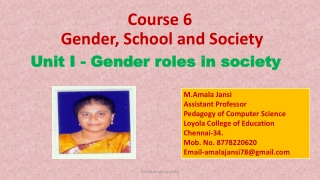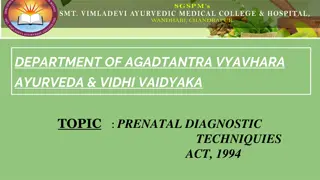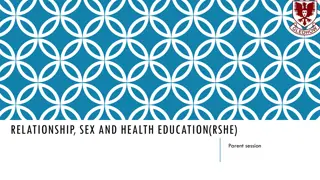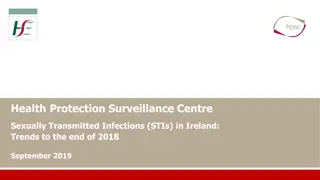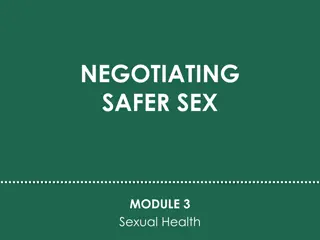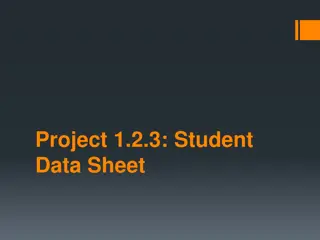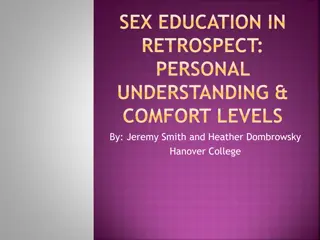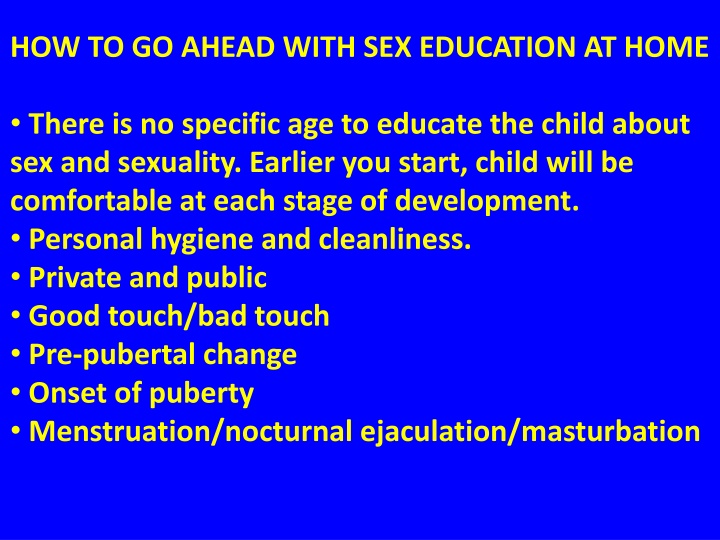
Empower Your Child through Home Sex Education & Personal Accountability
Start sex education at home early to foster comfort and understanding at each developmental stage. Teach hygiene, boundaries, pre-pubertal changes, and more. Instill a sense of responsibility and belongingness by promoting cleanliness and discipline. Discuss privacy using color codes for different stages of privacy. Educate your child about public and private spaces with the analogy of traffic lights. Foster a safe environment for learning and growth.
Download Presentation

Please find below an Image/Link to download the presentation.
The content on the website is provided AS IS for your information and personal use only. It may not be sold, licensed, or shared on other websites without obtaining consent from the author. If you encounter any issues during the download, it is possible that the publisher has removed the file from their server.
You are allowed to download the files provided on this website for personal or commercial use, subject to the condition that they are used lawfully. All files are the property of their respective owners.
The content on the website is provided AS IS for your information and personal use only. It may not be sold, licensed, or shared on other websites without obtaining consent from the author.
E N D
Presentation Transcript
HOW TO GO AHEAD WITH SEX EDUCATION AT HOME There is no specific age to educate the child about sex and sexuality. Earlier you start, child will be comfortable at each stage of development. Personal hygiene and cleanliness. Private and public Good touch/bad touch Pre-pubertal change Onset of puberty Menstruation/nocturnal ejaculation/masturbation
Keep the body clean Understand & follow the command NO Use waste paper basket Keep home tidy Help in daily chores Dress tidy Mannerism & discipline Learn through consequences All the above helps to build sense of responsibility & belongingness/ownership
Our children need to understand about privacy. It helps to discuss privacy by talking about the colours that can be used to signify various stages of privacy ranging from private to public. Think about the colours of the traffic signals green, red and yellow. You may use coloured cards as you talk about each concept.
Ensure your child understands the traffic signals concept before you start. Red stands for things that are private Yellow stands for Be Careful . Green stands for things that are public & protected.
Anyone can go there. There is usually no doorbell and you would not need to knock or ask permission to enter. Banks, post office, library, restaurant, place of worship etc. Some rooms in our homes are public. There is not usually a door on these rooms except for the main entrance where there is a doorbell. There may be strangers in these places.
These are found in public places. A changing room in the store. In gatherings, at parties & picnics when we are with mixed crowd. At railway station/bus-station/market/ parks/fair/mall/multiplex etc. We need to be careful when we use these places. BE CAREFUL EVERYTIME WHEN STRANGER IS AROUND
There are very few private places in our lives. Usually they are just found in our homes- our bedroom and our bathroom. We need to do things to make our private areas very private. We would shut the door and close the curtains. If someone wants to enter another person s private places, they must knock on the door and wait to be invited in. When we are in our private places, we can do anything we want
DISCOURAGE Dressing and undressing in public/with door kept open. Running naked between bathroom and bedroom. Leaving the door open while using the toilet Changing into/out of swimwear at the pool/beach Pull down wet cloth/pant in a public room at home Parents/grandparents not maintaining privacy.
I cover my body wearing a bathrobe after my shower.
Help your child to bathe but dont take bath with your child. It s fun to play together with water while children are bathing . Don t let your fun get buried have fun but follow the swim suit rule. Don t change cloths in front/in presence of your child. Close the door of your room while changing. Don t keep the doors open while using the bathroom/toilet.
Explaining the pre-pubertal changes Now we are focusing on the reproductive system. Collect your photos right from your childhood & arrange them stepwise, this would facilitate to talk about the physical changes.
PRE-PUBRTY PUBERTY ADULT
PRE-PUBRTY PUBERTY ADULT
1. Choose the method of sanitation that suits the best & then stick to that. 2. Change regularly. Napkin once every 6 hours & tampon every 2 hours. Be very careful if you have selected to use tampon. If not done it can lead to conditions like urinary tract infection, vaginal infections and skin rashes.. 3. Wash or wipe off regularly. 4. No need to use soap or vaginal hygiene products.
5. Use the right washing technique: Always wash or clean the area in a motion that is from the vagina to the anus. 6. Discard your used sanitary product properly They are capable of spreading infections. Wash your hands well after you discard your used napkin . 7. Beware of a pad rash Stay dry during your periods. Apply an antiseptic ointment, after a bath and before bed
8. Use only one method of sanitation at a time Even when you have heavy flow do not use either (i) two sanitary pads, (ii) a tampon and sanitary pad (iii) a sanitary pad along with a piece of cloth. This can lead to rashes and infections. Using a piece of cloth is not a good idea 9. Have a bath regularly Having a bath is the best thing you can do for your body during your periods. It also helps relieve menstrual cramps, backaches, helps improve your mood.
10.Be ready with on-the-go stuff during your periods. When you have your periods it is important to be ready. It is important to have extra sanitary pads or tampons properly stored in a clean pouch or paper bag, a soft towel, some paper tissues or towels, hand sanitizer, a healthy snack, bottle of drinking water, a tube of antiseptic medication. (if you are using one).
Masturbation is common throughout .Children masturbate from an early age. The behaviour usually increases during adolescence. Masturbation is a natural thing for children and adults to do. Masturbation may also be a symptom of non- sexual problems such as frustration, boredom, or loneliness. Masturbation may seem excessive because it occurs in inappropriate places. This may happen because an individual has no appropriate places to masturbate or because he or she hasn t been taught where it is appropriate to masturbate.
Excessive masturbation may occur: When there are personal emotional problems When there is an irritation such as a skin rash When clothing is too tight When there is an infection When a physical disability affects sensitivity to pain or pleasure
when an individual has a general tendency to engage in obsessive, repetitive, and/or self-abusive behaviour when an individual has hyposensitivity to touch. This individual may need to masturbate longer or more forcefully just to get sufficient sensations. As an attention-getting behaviour when an individual has been sexually abused
Masturbation cannot be ignored: when it is done in a public place when it is done in a private place (such as a bedroom), but when other people are around when it interferes with daily living (the individual no longer finds time for family or friends, other interests, schoolwork, or their job) when an individual is rubbing so hard or so often that there is soreness or bleeding
Individuals may need to learn the following things: Masturbation should be done in a private place at home, such as a bedroom or a bathroom with the door closed and the curtains drawn. Masturbation is a private behaviour that should be done alone. Clean up after masturbating this includes wiping off the genitals, wiping up semen (for males), and washing hands. Masturbation should not be discussed in public places with family, friends, or strangers. Masturbation can be discussed in private with a doctor, nurse, parent, or other appropriate person.
Dealing with Inappropriate Masturbation Be clear about your rules. Respond to inappropriate masturbation in a calm, non-judgmental manner. Use clear language. For example, It s not okay to masturbate here. You can do that in the bathroom. If possible, coordinate the messages given at home and at school or work, so that you and all school or work staff are giving consistent messages. Look for possible causes if the inappropriate behaviour persists.
Behavior modification techniques can be applied to inappropriate masturbation. Possible techniques include: Encourage other, incompatible behaviors your child won t be able to masturbate if their hands are busy doing something else. Reward appropriate behavior or the absence of inappropriate behavior. Extinguish attention-getting behavior by ignoring it or calmly redirecting your child. This may be difficult masturbation is a very private behavior, and seeing it in public may cause feelings such as anger, fear, or disgust. www.imwidu.blogspot.in BEHAVIOUR MODIFICATION TECHNIQUES


